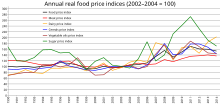Food prices
[2] Geopolitical events, global demand, exchange rates,[3] government policy, diseases and crop yield, energy costs, availability of natural resources for agriculture,[4] food speculation,[5][6][7] changes in the use of soil and weather events directly affect food prices.
[9][10][11] Increases in food prices is related to disparities in diet quality and health,[12] particularly among vulnerable populations, such as women and children.
[24][25] Consumer prices in the rich countries are massively influenced by the power of discount stores and constitute only a small part of the entire cost of living.
For some product classes like dairy or meat, overproduction has twisted the price relations in a way utterly unknown in underdeveloped countries ("butter mountain").
The situation for poor societies is worsened by certain free trade agreements that allow easier export of food in the "southern" direction than vice versa.
[39][40] In June 2011, food price inflation in the United Kingdom reached its highest rate in nearly two years, driven primarily by rising energy costs.
The inflationary pressures affected businesses across the food supply chain, including Gail's Bakery, where Managing Director Tom Molnar reported significant impacts on their operations.
Economist Brian Hilliard from Societe Generale highlighted that the surge in oil prices was a key factor driving the overall increase in food costs.
In the 1980s and 1990s, farm subsidies and support programs allowed major grain exporting countries to hold large surpluses which could be tapped during food shortages to keep prices down.
However, new trade policies have made agricultural production much more responsive to market demands, putting global food reserves at their lowest since 1983.
[42] Food prices are rising, wealthier Asian consumers are westernizing their diets, and farmers and nations of the third world are struggling to keep up the pace.
Asian nations have contributed at a more rapid growth rate in the past five years to the global fluid and powdered milk manufacturing industry.
Rising food prices over recent years have been linked with social unrest around the world, including rioting in Bangladesh and Mexico,[43] and the Arab Spring.
[44] In 2013, Overseas Development Institute researchers showed that rice has more than doubled in price since 2000, rising by 120% in real terms.
Most of the data for the February report was compiled before the 2022 Russian invasion of Ukraine, but analysts said a prolonged conflict could have a major effect on grain exports catalyzing a further food crises.
[49][50][51] In March 2024, Nigeria's food inflation rate reached 40.01% year-on-year, driven by currency depreciation, supply chain disruptions, and rising agricultural input costs.



